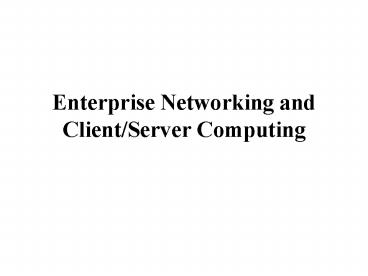Enterprise Networking and ClientServer Computing - PowerPoint PPT Presentation
1 / 21
Title:
Enterprise Networking and ClientServer Computing
Description:
Enterprise Networking and ClientServer Computing – PowerPoint PPT presentation
Number of Views:68
Avg rating:3.0/5.0
Title: Enterprise Networking and ClientServer Computing
1
Enterprise Networking and Client/Server Computing
2
Enterprise-Wide Computing
- A method of providing cost-effective computer
capability wherever it is appropriate within an
organization. Provides computer capability on
multiple processors that can process
independently and that also interact regularly by
exchanging data over a network - Linking all sites, possibly covering several
geographic regions, together into one large
network - Data and programs relative to one local site can
be shared by several sites, thus overcoming time
and space limitations
3
Networking Operating System
- Controls all operations and functions within the
networks domain - Just as your brain tells your body parts how to
function and work together, the software governs
the way computers in the network communicate with
each other and perform functions
4
Advantages of the Enterprise-Wide Networking Model
- Cost reductions through the sharing of resources
- Hardware and software usage can be maximized and
create efficiencies - Networked computers allow teams to work more
efficiently as data and other resources can be
maintained in a central location - When data does need to be routed, it can easily
and efficiently be controlled
5
Fundamental Capabilities of Networks
- Improves response time
- Enables the formation of strategic alliances
- Suppliers can share your data and automatically
replenish inventories when necessary - Distributes one or more of the following
- Information processing
- 2-tier and 3-tier architectures
- Networking processing
- Data base storage
6
Electronic Data Interchange(EDI)
- EDI is the electronic exchange of routine
business transactions (orders, invoices, etc.)
between different organizations using a
standardized, computer-readable format - EDI transfers data in a format that is directly
readable by the computer without any manual
intervention - EDI standards are critical to its success.
Thousands of companies worldwide use EDI to
communicate directly with customers to process
orders, pay bills, and manage inventory - Examples Super Valu, Walmart, GM, PG
7
Challenges of Enterprise-Wide Networking
- Connectivity
- Dissimilar network components often give way to
incompatibility issues - More difficult to maintain control over the
assets of the organization - Organizational changes are required because of
decentralization of resources - Network reliability and security
8
Client/Server Computing
9
Client/Server Computing
- A model of computing where different computer
platforms or servers are dedicated to special
functions. Each server is potentially accessible
by all other computer platforms on the network. - For example, one server could only hold data and
another server contains the application - A client is a user workstation or PC that asks
for services from the servers on the network.
10
2-Tier Client/Server Model
11
3-Tier Client/Server Model
12
Client/Server Analogy
- Restaurant service is an analogy to help explain
client/server computing. The customer (client)
makes a series of requests for a specific set of
services that may include an appetizer, beverage,
main course and a dessert.
13
Client/Server Analogy
- The customer doesn't want to know who performs
what service. He would just like to have a high
quality meal delivered in a timely fashion.
14
Advantages of Client/Server Computing
- Potential of reduced cost
- Be careful here
- Improved performance
- Increased security
- More intuitive interfaces
- Better software development tools once a level of
proficiency is achieved
15
Disadvantages of Client/Server Computing
- Heavy up-front costs
- Initial performance decline
- Newer tools and software development processes
- Lack of skilled professionals
- Training and re-training issues
16
Competitive Advantages of Client/Server Computing
- Reduced time to market
- Improved Customer service
- Simplicity
17
Decentralized Operations
- Decentralizing IT operations puts computing power
and data access in the hands of the users,
transforming clerical workers into "knowledge
workers". This increases the productivity of MIS
staff by reducing trivial requests and allowing
them to concentrate on mission-critical
applications. Client/server architectures improve
the service you can offer by supplying
information at the point closest to your customers
18
Event-Driven vs Menu-Driven Programming
- Menu-driven
- Used by mainframe applications and DOS_Based
applications - The programmer guides the user through a series
of options - Event-Driven
- Used by Windows-Based applications
- The programmer codes for the many events that a
user can perform - Click, Double-click, Drag, Drop, Resize,
Radio-buttons, Checkboxes, etc.
19
Expected Costs of Client/Server Computing
- New Hardware
- New Software
- New Networking
- New Training
20
Management Issues
- Technical Issues
- Organizational Issues
- Business/Economic Issues
- Security Concerns
21
Solutions to Management Issues
- Proper planning and management when converting or
installing enterprise-wide systems - Education and training to teach employees how to
use the software and hardware efficiently - Establishing a data administration function to
determine where the data is, who is responsible
for the data, and who can access the data































